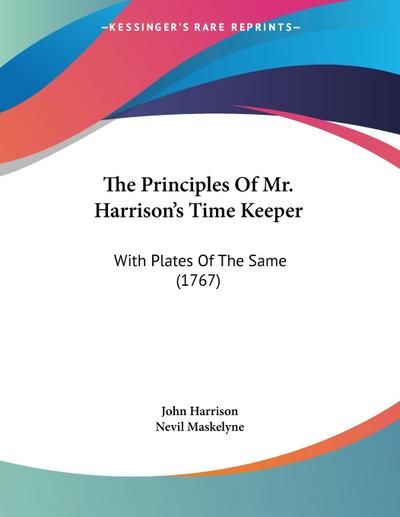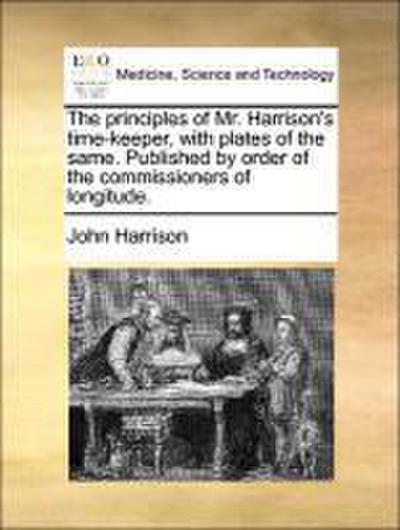Search results 29 Found
The Principles of Mr. Harrison's Time-Keeper: With Plates of the Same
The Principles of Mr. Harrison's Time-Keeper: With Plates of the Same
Harrison, John
- Publisher: Legare Street Press
- Date published: 2022
- Format: Hardcover
- ISBN: 9781015708976
In
riachristiecollections-34.84-204fad7112dca6c6f72c5c453b5bc633
The Principles of Mr. Harrison's Time-Keeper
The Principles of Mr. Harrison's Time-Keeper
Harrison, John, and Great Britain Commissioners of Longi (Creator)
- Publisher: LEGARE STREET PR
- Date published: 10/27/2022 12: 00: 00 AM
- Format: Hardcover
- ISBN: 9781015708976
New Book. Shipped from UK in 4 to 14 days. Established seller since 2000. Please note we cannot offer an expedited shipping service from the UK.
paperbackshop-35.40-2a0efcceb28716bda5baa43307c00208
The Principles Of Mr. Harrison's Time Keeper : With Plates Of The Same (1767)

The Principles Of Mr. Harrison's Time Keeper : With Plates Of The Same (1767)
John Harrison
- Publisher: Kessinger Publishing, LLC
- Date published: 2009
- Format: Softcover
- ISBN: 9781104323851
nach der Bestellung gedruckt Neuware - Printed after ordering - The Principles of Mr. Harrison's Time Keeper: With Plates of the Same is a book written by John Harrison and published in 1767. The book is a detailed explanation of the principles behind Harrison's invention of a marine chronometer. The marine chronometer was a device used to accurately measure time at sea, which was crucial for navigation and the calculation of longitude. The book includes detailed diagrams and illustrations of the marine chronometer, as well as explanations of the various components and how they work together to accurately measure time. Harrison's invention was a significant breakthrough in the field of navigation, and his work was instrumental in solving the problem of determining longitude at sea.The book is considered a classic in the field of horology and is still referenced by modern watchmakers and clockmakers. It provides a fascinating insight into the history of timekeeping and the development of accurate time measurement devices. Overall, The Principles of Mr. Harrison's Time Keeper: With Plates of the Same is a valuable resource for anyone interested in the history of horology or the science of time measurement.This scarce antiquarian book is a facsimile reprint of the old original and may contain some imperfections such as library marks and notations. Because we believe this work is culturally important, we have made it available as part of our commitment for protecting, preserving, and promoting the world's literature in affordable, high quality, modern editions, that are true to their original work.
ahabuchgmbh-35.98-5fd2a5623d24cba689782709aca90771
The Principles of Mr. Harrison's Time-Keeper
The Principles of Mr. Harrison's Time-Keeper
Harrison, John, and Great Britain Commissioners of Longi (Creator)
- Publisher: LEGARE STREET PR
- Date published: 10/27/2022 12: 00: 00 AM
- Format: Softcover
- ISBN: 9781015713239
New Book. Shipped from UK in 4 to 14 days. Established seller since 2000. Please note we cannot offer an expedited shipping service from the UK.
paperbackshop-36.46-2a0efcceb28716bda5baa43307c00208
Principles of Mr. Harrison's Time-Keeper, with Plates of the

Principles of Mr. Harrison's Time-Keeper, with Plates of the
John Harrison
- Publisher: BERTRAMS PRINT ON DEMAND Jun 2010
- Date published: 2010
- Format: Softcover
- ISBN: 9781170151815
Neuware - The 18th century was a wealth of knowledge, exploration and rapidly growing technology and expanding record-keeping made possible by advances in the printing press. In its determination to preserve the century of revolution, Gale initiated a revolution of its own: digitization of epic proportions to preserve these invaluable works in the largest archive of its kind. Now for the first time these high-quality digital copies of original 18th century manuscripts are available in print, making them highly accessible to libraries, undergraduate students, and independent scholars.Medical theory and practice of the 1700s developed rapidly, as is evidenced by the extensive collection, which includes descriptions of diseases, their conditions, and treatments. Books on science and technology, agriculture, military technology, natural philosophy, even cookbooks, are all contained here. ++++ The below data was compiled from various identification fields in the bibliographic record of this title. This data is provided as an additional tool in helping to insure edition identification: ++++ British Library T060484 The prefatory 'Notes' are signed: Nevil MasKelyne. In this impression the plates are on India paper and not folded; collation: [A-B], C-P, [Q] for the letterpress. With a half-title. London : printed by W. Richardson and S. Clark; and sold by John Nourse, and Mess. Mount and Page, 1767. 31,[1]p.,plates ; obl.4°
ahabuchgmbh-37.20-f3adb2a9e9fb1a4a8b125807573e8147
The Principles of Mr. Harrison's Time-Keeper
The Principles of Mr. Harrison's Time-Keeper
Harrison, John, and Great Britain Commissioners of Longi (Creator)
- Publisher: LEGARE STREET PR
- Date published: 10/27/2022 12: 00: 00 AM
- Format: Hardcover
- ISBN: 9781015708976
PLEASE NOTE, WE DO NOT SHIP TO DENMARK. New Book. Shipped from UK in 4 to 14 days. Established seller since 2000. Please note we cannot offer an expedited shipping service from the UK.
books2anywhere-41.39-2a0efcceb28716bda5baa43307c00208
The Principles of Mr. Harrison's Time-Keeper
The Principles of Mr. Harrison's Time-Keeper
Harrison, John, and Great Britain Commissioners of Longi (Creator)
- Publisher: LEGARE STREET PR
- Date published: 10/27/2022 12: 00: 00 AM
- Format: Hardcover
- ISBN: 9781015708976
PLEASE NOTE, WE DO NOT SHIP TO DENMARK. New Book. Shipped from UK in 4 to 14 days. Established seller since 2000. Please note we cannot offer an expedited shipping service from the UK.
books2anywhere-45.06-2a0efcceb28716bda5baa43307c00208
The Principles of Mr. Harrison's Time-Keeper: With Plates of the Same
The Principles of Mr. Harrison's Time-Keeper: With Plates of the Same
Harrison, John, and Great Britain Commissioners of Longi (Creator)
- Publisher: Legare Street Press
- Date published: 2022
- Format: Hard cover
- ISBN: 9781015708976
Sewn binding. Cloth over boards. 58 p.
alibris-49.83-7fa9dbb70dc231be0d44dbd522446445
The Principles of Mr. Harrison's Time-Keeper
The Principles of Mr. Harrison's Time-Keeper
Harrison, John, and Great Britain Commissioners of Longi (Creator)
- Publisher: LEGARE STREET PR
- Date published: 10/27/2022 12: 00: 00 AM
- Format: Hardcover
- ISBN: 9781015708976
New Book. Shipped from UK in 4 to 14 days. Established seller since 2000. Please note we cannot offer an expedited shipping service from the UK.
paperbackshop-60.85-2a0efcceb28716bda5baa43307c00208
